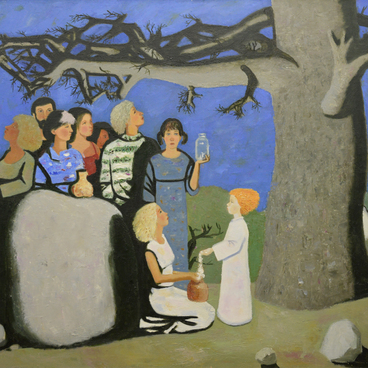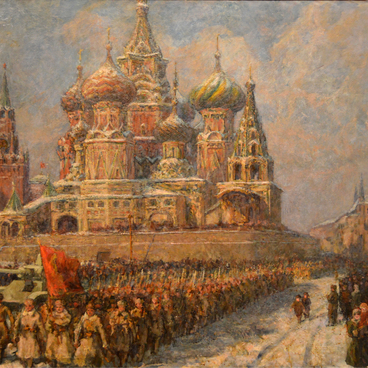When speaking of the constellation of talented Kurgan painters, it’s important to mention Vladimir Chaly, a Kurgan-born painter of postmodernist epoch, and a prominent figure of the Trans-Uralian art. Together with his like-minded fellows, other young painters, in the mid-1980s he made radical change to the local school of painting. After the early passing of Alexander Petukhov, who represented an alternative to the official art, there were no followers of the artist with his art, expressive in form and often full of conflicts in its content, left.
The Severe Style was gradually being replaced by a certain stagnancy in art. The Trans-Uralian art became traditionalist. The artists applied to the art of the past, the beauty of the outside world. The declarative and pompous style of works in the frame of exhibitions arranged for the memorial dates was another tendency. A new generation of artists with Vladimir Chaly (after his moving to Kurgan) as a leader was interested in art itself outside the party ideology. “I never analyze the painting beforehand. I”d never paint if I knew what I”d have in the end. I”m just interested. Painting is both my job and my hobby’, said the artist while characterizing his own art. He was always free whether choosing the subjects for his paintings or in his pictorial manner. Vladimir Chaly asked not to search for the hidden themes and complicated motifs in his art. Among Chaly’s favourite painters were such modernists as Modigliani, Picasso, Malevich. Their spiritual influence is distinctive in his compositions including his Self Portrait made in 1992.
The work features a universal painter who is able, according to Chaly, to endlessly change and transform his image and nonetheless stay authentic. That’s why his face on the self portrait is shown as a blank white oval like the ones on the paintings by Kazimir Malevich. At the same time the artist showed a certain generalized image here. Chaly highlighted the palette, the hand and the face of himself as an artist with white colour.
A palette cuts the painting’s space like an edge of a knife, which it reminds of with its shape as well. The artist used an interesting composition effect. He separated the hand with the thin strip of wood from his figure. The dark green background colour, which the artist loved a lot, gives the portrait a noble tone.
The Severe Style was gradually being replaced by a certain stagnancy in art. The Trans-Uralian art became traditionalist. The artists applied to the art of the past, the beauty of the outside world. The declarative and pompous style of works in the frame of exhibitions arranged for the memorial dates was another tendency. A new generation of artists with Vladimir Chaly (after his moving to Kurgan) as a leader was interested in art itself outside the party ideology. “I never analyze the painting beforehand. I”d never paint if I knew what I”d have in the end. I”m just interested. Painting is both my job and my hobby’, said the artist while characterizing his own art. He was always free whether choosing the subjects for his paintings or in his pictorial manner. Vladimir Chaly asked not to search for the hidden themes and complicated motifs in his art. Among Chaly’s favourite painters were such modernists as Modigliani, Picasso, Malevich. Their spiritual influence is distinctive in his compositions including his Self Portrait made in 1992.
The work features a universal painter who is able, according to Chaly, to endlessly change and transform his image and nonetheless stay authentic. That’s why his face on the self portrait is shown as a blank white oval like the ones on the paintings by Kazimir Malevich. At the same time the artist showed a certain generalized image here. Chaly highlighted the palette, the hand and the face of himself as an artist with white colour.
A palette cuts the painting’s space like an edge of a knife, which it reminds of with its shape as well. The artist used an interesting composition effect. He separated the hand with the thin strip of wood from his figure. The dark green background colour, which the artist loved a lot, gives the portrait a noble tone.

